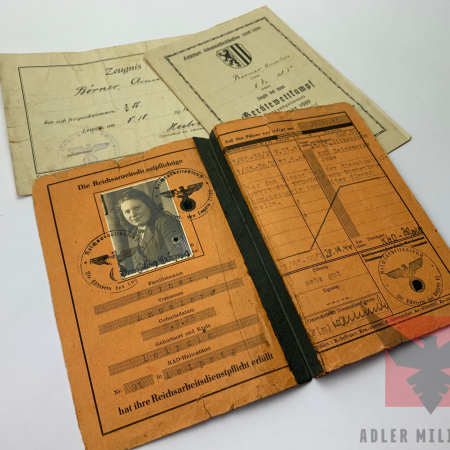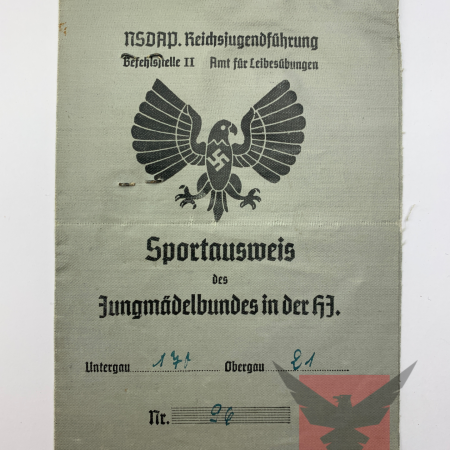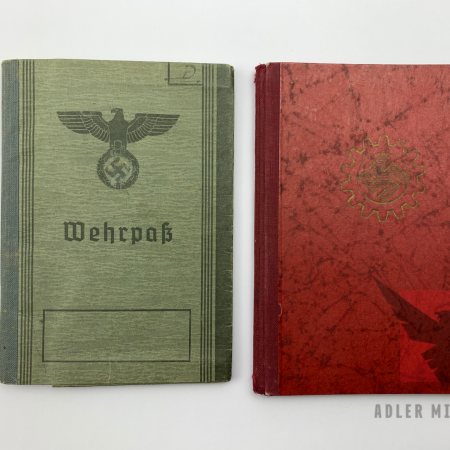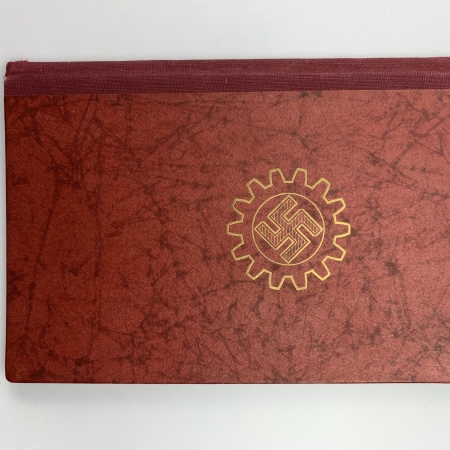Showing 1072–1080 of 1325 resultsSorted by latest
-

WW2 German Issue – ‘Storm Lighter’
WW2 German Storm Lighter
Original WW2 German issued storm lighter, Mint condition!
Ready to use! Body made of aluminum, ideal ‘bread bag’ item or perfect item for display!
Free Shipping within the USA and Europe!
-

WW2 German Soldbuch – Pz.Nach.Reg ‘Brandenburg’ – Radio Operator – ‘Battle of Bautzen’
Regiment Brandenberg Radio Operator Soldbuch.
This complete Soldbuch issued with photo is in good & clean condition and belonged to a Radio operator within the elite Brandenberg division.
Gunther Becker was a young 17-year-old Berliner when he entered service into the military in April 1944 as can be seen from his photo upon opening the Soldbuch. From his Soldbuch entries, we can see that he entered military training with the Großdeutschland division.
After completing training within the Großdeutschland division he distinguished himself as a competent communications technician, then served within the Großdeutschland division as a radio and communications operator before being posted to Cottbus with the Panzer-Nachrichten-Ersatz-und-Ausbildungs-Abteilung Großdeutschland.
Gunther stayed with the Großdeutschland division until the end of December 1944 when he then joined the newly formed Brandenburg division which was part of the Panzerkorps Großdeutschland.
Gunther was issued a K98 rifle & joined the 1st Kompanie of Panzer Nachrichten-Abteilung Brandenburg, a communications unit that was operating in East Prussia in the area of the Masurian Lakes.
The division was in need of fresh manpower after taking heavy losses in November 1944 after heavy battles in Serbia and Croatia.
The Russian advance across Poland smashed the German defences in most sectors, one such was south of the city of Litzmanstadt ( now the Polish city of Lodz ) in early January of 1945 the Brandenberg division were sent by train to defend positions on the outskirts of Lodz along with elements from the Herman Goering division. Here they held their ground but after taking heavy losses they had to perform fighting withdrawals towards the Elbe – Elster where the division once again tried to stop the Soviet advance. Due to how late in the war it was and how chaotic it was Gunther had not many entries in his Soldbuch when it seems he should have.
Gunther was involved in the Battle of Bautzen at the end of April 1945 when the Brandenburg division along with the 1. Fallschirm-Panzer-Division-HG where they achieved a small victory as they smashed and took out over half of the Polish 2nd Army's armored cars.
The division had been defending the eastern bank of the Oder river against superior Russian enemy forces until May 1945 when they tried to flee to American lines to surrender, some were taken by the US but most were taken by Soviet forces. The members of the division not able to reach American lines fell into Soviet captivity in the Czech city of Brod.
We can clearly see from Page 1 within the Soldbuch that Gunther was taken prisoner by the Soviets since his name has been written in Russian on the page also.
Brandenburgers Divisional Sign (Below)
-

WW2 German Family Work Books – Arbeitsbücher – DAF – S.Bergbau ‘Reichswerke Hermann Göring’ (Sold)
A grouping of four books.One is stamped with: Sudetenländische Bergbau Brüx.All owners are relatives same surname, this was found in a house clearance together in Germany in 2018. -

WW2 German Issue – RAD Identification Pass for Lady – ‘Reichsarbeitsdienst-Paß’ – Zeiss Werke Jena 1944 (Sold)
R.A.D Service ID for Annelore Börner from Leipzig.
Worked for Carl Zeiss Optic Manufacturer in Jena Germany during the war. Carl Zeiss made many different Optical equipment for the German Armed Forces.Carl Zeiss used slave labourers during the war.A total of around 8,000 people were forced to work on the various locations for Carl Zeiss.Unusual R.A.D ID, directly linked to the wartime production of the most famous optical equipment. -

WW2 German BDM Sport ID – ‘Jungmädelbundes HJ’ – Süd Baden
WW2 German BDM Sport ID – ‘Jungmädelbundes HJ’ Süd Baden
Sport ID for Jungmädel Schaftf. Maria Pfaff, from Oberkirk.Issued in Offenburg, 26.6.1943Originally applied Photograph, Uniform of the BDM, clearly seen is the arm insignia for Süd Baden.Very rare ID in this form. -

WW2 German Wehrmacht Soldbuch – Stabsfeldwebel – Battle of Bautzen 1945 – ‘Kampfgruppe Moser’ Luger P08
Stabsfeldwebel Müller – Battle of Bautzen 1945 – ‘Kampfgruppe Moser’
Issued to Stabsfeldwebel Rudolf Müller born on the 9th of February 1911 in Penig in Sachsen into a Protestant family. Müller was a Machine Engineer in his civilian life.Wehrmacht Soldbuch – 2nd Issue – 14 July 1944 in Fulda, Germany with Grenadier Ersatz Batl 88.One month later (August 1944) Müller was assigned to the Stabsbat IV./Artillerie Regiment 1544 (under the 544 Volks Grenadier Division) fighting with Heeres Gruppe A and Mitte into Poland and Oberschlesien in 1945.Equipment & Weapons: Issued a Luger P08 9mm Pistol, Compass, Visor Cap, Winter Boots. Also Ration entries: December 1944 x1 Iron Portion. Also in April 1945.Müller served with Feld Ersatz Batalion 208 (208 Infanterie Division) sometime in 1945, but by February Müller arrived in Hospital in Amstetten in Austria with a code 34 wound (Accident or Self Mutilation) but was sent back to another unit in March 1945 after leave.He was sent to Dresden, which must have been at this late state nearly completely destroyed by the Allied Air Raids. Müller arrived with the Artillerie-Ersatz- und Ausbildungs-Abteilung 40 in Dresden. They were mobilised in April 1945, and attached to Division Nr 404 fighting under Kampfgruppe Moser. Müller was issued Rations for April 1945 to prepare for combat operations. The division was fighting on Two Fronts, with both the US Army and the Red Army.April and May 1945 Battle of Bautzen, LöbauThe battle took place during Ivan Konev’s 1st Ukrainian Front’s push toward Berlin, which was part of the larger Soviet Berlin Offensive. The battle was fought in the town of Bautzen (Polish: Budziszyn) and the rural areas to the northeast situated primarily along the Bautzen–Niesky line. Major combat began on 21 April 1945 and continued until 26 April although isolated engagements continued to take place until 30 April. The Polish Second Army under Karol Świerczewski suffered heavy losses, but, with the aid of Soviet reinforcements, prevented the German forces from breaking through to their rear.
After the battle both sides claimed victory and modern views as to who won the battle remain contradictory. Because the war was almost over and the battle had no strategic impact on the ongoing Battle of Berlin, German historiography has focused more on its tactical aspects. The German operation successfully recaptured Bautzen and its surroundings, which were held until the end of the war.
An interesting late war Soldbuch to an experienced NCO who was transferred from the Luftwaffe to the Wehrmacht. Nice Period applied photo. Included is a photograph of Müller before his transfer to the Wehrmacht still in his Luftwaffe Tunic. -

WW2 German Luftwaffe Soldbuch – Funkmeister Kreutzer – ‘Kampfgruppe von Heinemann’ – MP40 & Panzerfaust!
Funkmeister Fritz Kreutzer – Kampfgruppe von Heinemann 1942
Kreutzer was born into a Protestant family on the 16th of June 1914 in the area of Heiligenwald in the former Eastern Prussia. Kreutzer was a Sales Man by trade and was married.Soldbuch Issued – 2nd Issue – 17th of September by Luftnachrichten Regiment 38.Kreutzer was a master radioman, adorned with the rank of Feldwebel Funkmeister. (Sergeant – Radio Master).Kreutzer served from 1.5.1942 – 2.12.1944 with Luftnachrichten Regiment 38, ending the war out with the rest of Luftwaffenkommando VIII.Injuries or Wounds: Kreutzer arrived on the 22nd of February 1942 in Hospital due to a bomb splinter hitting his left upper leg. Returned to his unit around two months later.Late 1942 Kreutzer’s unit was attached to Kampgruppe von Heinemann. Under Major Lothar von Heinemann. KG Heinemann went into action on the famous Soviet Tatsinskaya Airfield Raid in 1942. The most important airfield only 260KM away from the city of Stalingrad. It was the 6th Armees most important airbase, and the Soviet Army mounted a raid against the airport in late 1942.See More on the Battle: https://www.stalingrad.net/russian-hq/the-tatsinskaya-raid/the-tatsinskaya-raid.htmAccording to historian Robert Forczyk, in his book: Red Christmas: The Tatsinskaya Airfield Raid 1942. (Osprey 2012) Page 29.”Kampfgruppe von Heinemann was the largest blocking force, made up from both left over Flak unit at the men of Luftnachrichten Regiment 38: 200 Men, 6 x 8.8cm Flak, 12 x 2cm Flak.”Locations of Luftnachrichten Regiment 381.5.42 – 5.42 Kischlaw (West of Feodosia) 5.42 – 6.42 Chan-Saraj, Bachtschisseraj (4.6.) 23.6.42 – 9.7.42 Kursk 9.7.42 – 7.42 Nikolskoje 7.42 Tazinskaja end.7.42 – end.11.42 Oblivskaja end.11.42 – 12.42 Tazinskaja 12.42 – 29.1.43 Krimskij am Donez 29.1.43 – 31.3.43 Itschi-Grammatikovo 31.3.43 – 9.43 Mikojanovka 9.43 – 1.44 Belaya Tserkov 1.44 – 12.3.44 Winnitsa 12.3.44 – 25.3.44 Kamenetz-Podolsk 25.3.44 – 1.4.44 Stanislau 1.4.44 – 13.5.44 Lemberg 13.5.44 – 24.7.44 Lublin 24.7.44 – 26.7.44 Dubowo 29.7.44 – 8.44 Tarnow 8.44 – 5.9.44 Wittkowice 7.9.44 – 1.45 Krakau 1.45 – 13.2.45 Schweidnitz Equipment: Issued a full set of uniform and equipment in May 1944, including a Summer Uniform. Also a Issue Pocket Lamp.Weapons: Issued a Pistol Model 37, 7.65mm. MP40 Sub Machine Gun. On the 30th of November 1944 he was taught how to operate a Panzerfaust by the Wachkomp of Oberkommando des Heeres Gruppe A. Extra Paper: Mastloch Sprengschein, this is a permit for the blowing of holes for large antennas (Issued March 1943).Awards:1. Sudetenland Medal (1.10.1938)2. War Merit Cross 2nd Class with Swords (15.3.1942)3. Black Wounds Badge (10.4.1942)4. Eastern Front Medal 41/42 (18.8.1942)5. Ground Assault Badge of the Luftwaffe (29.9.1942)Issued a Führerpaket on the 3rd of November 1943 on his way home for leave. On the 26.11.1944 Kreutzer was sent home for 10 days, as his house was destroyed in a bombing raid.Kreutzer survived the war after a short stint in hospital just before the wars end on the Elbe in late 1945. -

WW2 German Wehrpass & D.A.F Set
Small Grouping to Richard Doll, a Civilian from Mühlhausen in Thüringen.
Wehrpass Issued: 12.Oct.1943 by Wehrbezirkskommando Mühlhausen, Oberstleutnant.According to page 5. Doll was not mustered, but was found fit for service according to the Oberkommando der Wehrmacht rules on the 14.1.1944 in the Landwehr IA.Dolls DAF Workbook is filled out and has stamps till December 1944.Great filler for those not wishing to spend too much on a display. -

WW2 German D.A.F Membership Book – Berliner Lady – Many Stamps
Standard Membership Book.Stamps from 1.1936 to late 1940Near mint condition, perfect for an ID display.





